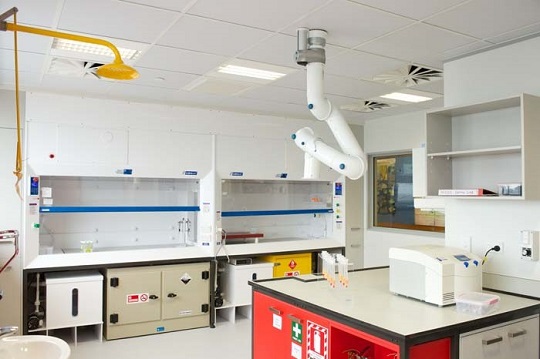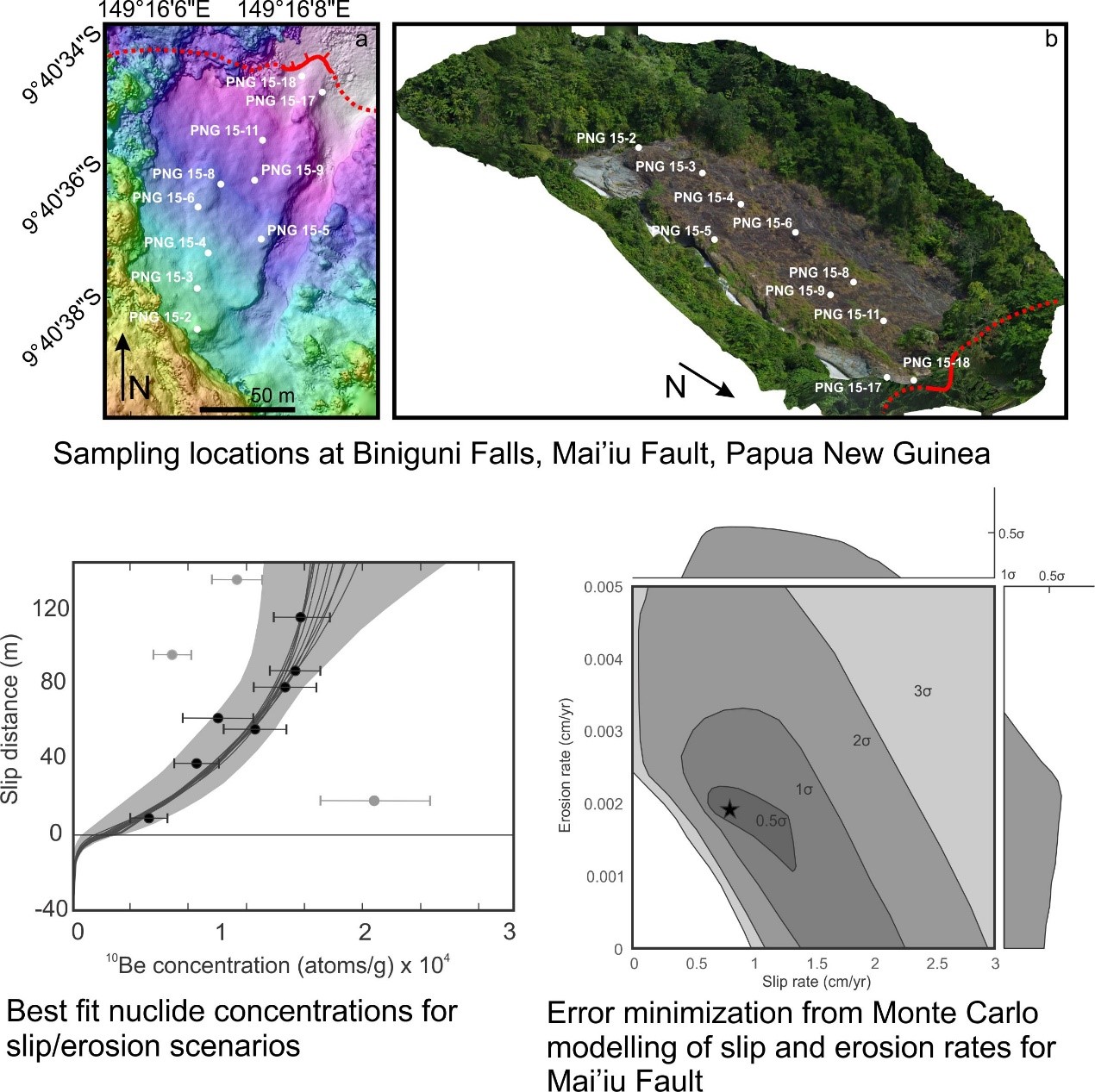Cosmogenic Nuclide Laboratory
Take the virtual tour of the Cosmogenic Nuclide Lab
Cosmogenic nuclides, such as beryllium-10, aluminium-26, and carbon-14 among others, are rare isotopes of elements produced through interactions of cosmic radiation with nuclei in Earth’s atmosphere and near surface. Because we know the rates at which these isotopes are produced, the concentrations of cosmogenic nuclides in rock, soil, sediment, etc. can be used to determine how long that material has been exposed at Earth’s surface. This allows us to calculate exposure ages and erosion rates at Earth’s surface.
The Cosmogenic Nuclide Laboratory at SGEES was purpose built in 2014 for the preparation of cosmogenic nuclide samples from all branches of the Earth sciences. The facilities include 2 HF rated extraction hoods and one laminar flow hood, Parr pressure dissolution oven, as well as analytical balances and centrifuge. We currently process >100 samples per year for a from a wide variety of lithologies, but have the capacity for ~200 samples per year.

The applications of cosmogenic nuclide methods span the Earth Sciences. Absolute dating of glacial moraines and river terraces, for example provide vital constraints on paleo-climate impacts on the landscape. Cosmogenic nuclides can be used to date fault scarps and the occurrence of large landslides, helping us understand tectonics and earthquake hazards and recurrence intervals. Soil production rates and erosion rates can likewise be determined by measuring nuclide concentrations in soils or river sediment, respectively, providing constraints of soil sustainability and flood hazard.

Present Team
- Claire Lukens - Chemical and physical weathering across tectonic and climatic gradients.
- Jamey Stutz – Antarctic glacial histories
- Kevin Norton - Geomorphology, etc.
- Shaun Eaves - Glacial geomorpholgy, palaeoclimate
- Marjolaine Verret (PhD) - Origin of ground-ice and organic carbon in Miocene sediments, Friis Hills, Antarctica
- Levan Tielidze (PhD) - Late Quaternary Glaciation of the Southern Alps and Greater Caucasus: an Interhemispheric Comparison of Past Climate Change at Mid-Latitudes
- Dina Fieman (PhD) – Quantifying the post-seismic sediment cascade and its impact on river dynamics
- Aidan McLean (PhD UniAuckland) - Records of Tectonics in the Rocky Coast – Advances in Terrestrial Cosmogenic Nuclide Application
- Emily Moore (MSc) - The glacial history of Rocky Top cirque, southeast Fiordland, New Zealand.
Past Members
- Maia Bellingham (MSc 2020) - Climatic effects on rapid chemical and physical denudation rates measured with cosmogenic nuclides in the Ōhau catchment, New Zealand
- Lisa Dowling (MSc 2019) - History of the Dart Glacier, Fiordland, New Zealand.
- Ross Whitmore (PhD 2020) - Reconstructing Holocene fluctuations of Mawson, Tucker, and Ironsides Glacier, Antarctica.
- Jamey Stutz (PhD 2020) – Non-linear, threshold-driven response of Antarctic outlet glaciers: Insights from David Glacier, Antarctica.
- Gavin Holden (MSc 2019) – Initiation and evolution of uplift at Mt Owen, New Zealand from cosmogenic nuclide-derived burial dating and environmental proxies.
- Juergen Oesterle (PhD 2019) – Timing and evolution of the Suckling-Dayman metamorphic core complex, Papua New Guinea
- Karsten Lorentz (MSc, 2018) – Bedrock to Soil: In-situ measurement and analytical techniques for initial weathering of proglacial environments.
- Aidan McLean (MSc, 2018) – Histories and Mechanisms of Change in the Development of Shore Platforms at Kaikōura and Rodney, New Zealand: Application of Cosmogenic Nuclides and Numerical Modelling on Exposed Coastal Surfaces.
- Cassandra Trinh-Le (MSc, 2017) – Dry sedimentation processes in the high-elevation McMurdo Dry Valleys, Antarctica: A case study in University Valley.
- Sam Webber (MSc, 2017) – The active Mai’iu low angle normal fault: Spatial and temporal slip distributions, and the chronology of rider block abandonment.
- Richard Jones (PhD, 2016) – Behaviour of outlet glaciers in the Transantarctic Mountains during the Late Cenozoic.
- Cam Watson (MSc, 2016) – Constraining an absolute age for the K-Surface and the determination of the vertical tectonic history of western Wellington.
- Julia Collins (MSc, 2015) – In-situ cosmogenic beryllium-10 in pyroxenes for moraine surface exposure dating.
- Abby Burdis (MSc, 2014) – Denudation rates derived from spatially-averaged cosmogenic nuclide analysis in Nelson/Tasman catchments, South Island, New Zealand.
